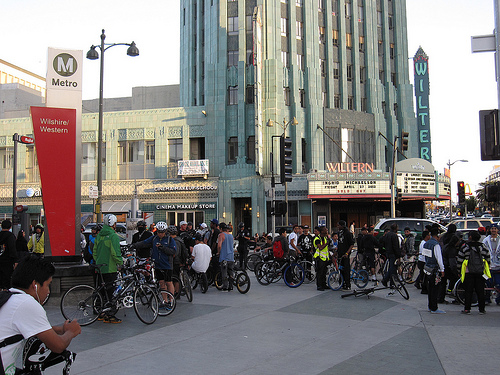Known for its car-centric culture, Los Angeles is primed for a reinvention as a walkable city, according to a new report from SmartGrowth America and George Washington University. The report, Foot Traffic Ahead: Ranking Walkable Urbanism in America’s Largest Metros, analyzed the number of walkable urban neighborhoods throughout 30 major metro areas. It also measured the potential for new, walkable development.

The Wiltern Theatre at the corner of Wilshire and Western, in the heart of one of L.A.’s more pedestrian-oriented neighborhoods. From InSapphoWeTrust.
While New York, Boston and Washington, D.C., were at the top of the rankings, Orlando, Florida came in last, and Los Angeles tied for 16th place, along with the metro areas of Kansas City and Columbus, Ohio. Los Angeles’ middle-of-the-road report ranking actually bodes well for the city, reports the Los Angeles Times: “[P]rospects for development around new Metro stations and continued revival of suburban downtowns, including Long Beach and Pasadena, will give more Angelenos the chance for a less auto-centric life in the years to come.”
Certain walkable neighborhoods in Los Angeles are experiencing growth, with office and real estate space rents priced higher than other areas designed around car travel, Chris Leinberger, a former developer and real estate professor at George Washington University and author of the report, told the Times. “This is a pretty significant change in how we invest, how we build the country… There will be demand for tens of millions of square feet of additional walkable urban development.”
Transitioning to a pedestrian-centered, walkable culture is not necessarily an easy proposition. Bureaucratic difficulties such as zoning codes can prevent or delay “dense, mixed-use” development projects, making “approvals far more complicated and expensive than a typical suburban strip mall.” Addressing zoning and other guidelines would further aid in making existing communities more walkable, and encouraging new development catering to walking consumers.
Another concern: As rents rise in these walkable and “increasingly high-end, concentrated neighborhoods,” poor and middle-class residents may be forced into the cheaper, but car-reliant, suburbs. As Leinberger explains to the Times, “‘Drive until you qualify’ does not work in a walkable urban development.” Cities can rely on help from tax credits and density bonuses to build and sustain reasonable housing in walkable areas, notes Rod Lawrence, a developer. “But it helps to make affordability a priority from the start of the planning process, before developers buy land and sink cash into market-rate projects.”
Developing walkable communities can be an economically savvy and politically geared decision as well. “Creating new Walkable Urban Places is a goal that elected officials and developers alike can get behind,” Emerick Corsi, President, Forest City Real Estate Services and Development said. “Based on the trends in Foot Traffic Ahead, there is the potential for market demand for tens of millions more square feet of walkable urban development—and hundreds of new WalkUPs—in America’s cities. Meeting that demand is an opportunity to create huge value for these communities.”
Los Angeles, the report notes, remains a work in progress, albeit one full of potential. “The future — of a walkable, transit-friendly Los Angeles — is being built right now,” says the report. “It will allow people to drive everywhere they want, assuming they can put up with the traffic, and provide the option of walkable urbanism for those who want it.”